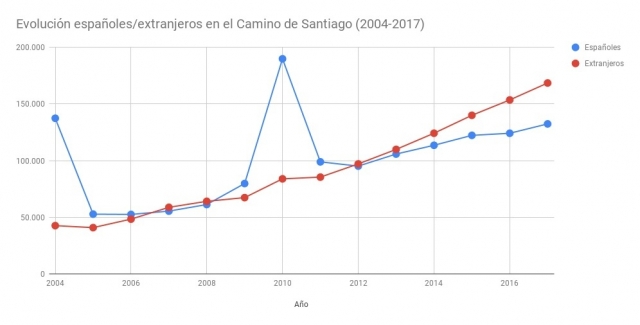By the end of October this year 317,000 Compostelas had been given out to Pilgrims already exceeding the total for the year in 2017 of 301, 036.
Pilgrim numbers have increased by about 45% over the past eight years leading to predictions that in the next Holy Year in 2021 (when Saint James' Day falls on a Sunday) there will be 500,000 Compostelas received.
This growth can clearly be seen on the below graph taken from https://vivecamino.com/en/the-records-of-the-camino-de-santiago:-the-evolution-in-numbers-no-540/ and based upon the information from the Cathedral in Santiago.

There are some who argue that Holy Years are the drivers for this growth - it was back in 1993 that the local government first began to advertise the Camino as a Cultural route (and came up with their first mascot) and the last Holy Year in 2010 saw 85% more Pilgrims than 2009 did.
There are also increasing numbers of non-Spanish Pilgrims on the route perhaps being influenced by media representations of the Camino such as 'The Way' so that in 2017 there were 35,000 more non-Spanish Pilgrims then there were Spanish Pilgrims.

Pilgrim numbers have increased by about 45% over the past eight years leading to predictions that in the next Holy Year in 2021 (when Saint James' Day falls on a Sunday) there will be 500,000 Compostelas received.
This growth can clearly be seen on the below graph taken from https://vivecamino.com/en/the-records-of-the-camino-de-santiago:-the-evolution-in-numbers-no-540/ and based upon the information from the Cathedral in Santiago.

There are some who argue that Holy Years are the drivers for this growth - it was back in 1993 that the local government first began to advertise the Camino as a Cultural route (and came up with their first mascot) and the last Holy Year in 2010 saw 85% more Pilgrims than 2009 did.
There are also increasing numbers of non-Spanish Pilgrims on the route perhaps being influenced by media representations of the Camino such as 'The Way' so that in 2017 there were 35,000 more non-Spanish Pilgrims then there were Spanish Pilgrims.

Image from https://vivecamino.com/en/the-records-of-the-camino-de-santiago:-the-evolution-in-numbers-no-540/
The popularity of the Camino seems set to continue to grow.
Comments
Post a Comment